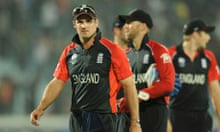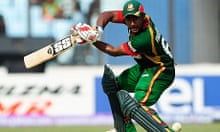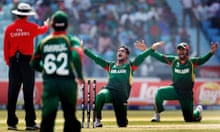The wicket is taller than the batsman. The wicket is a Colombo Municipal Council garbage bin that used to be green, but is now decorated with amber-white crow droppings. The bin is filled with plastic bags overflowing with uneaten curry. In front of it stands an eight-year old in a T-shirt eight sizes too large for him. The bin frames him as a doorway would an adult. If he leaves a ball whizzing past his shoulder, he will be out.
The bat is a plank that's been sawn into shape. It would reach the boy's chin if it were upright. Now it is held at an awkward angle, like a mamoty ploughing a paddyfield. My eyes do not go to the two ruffians in mosque hats crowding around the bat; nor to the pig-tailed girl behind the wicket, playing with the stray dog; nor to the tattered high rises, the ragged palm trees or the unkempt military checkpoint down the road. I stare at the boy with the shaggy hair, holding the ball.
A car slides down this dusty lane and waits until the over is finished. Over here, cars give way to cricket matches. In fact, these days, with Sri Lanka co-hosting the World Cup, everything gives way to cricket matches. TVs are switched on in offices, brothels, banks and tea shops. Work halts, roads empty and all the squabbling that has marked our last 50 years is put on hold.
We forget that we have coastlines to clear, refugees to settle, assassins to catch and most recently, floods to mop up. When a cricket match is on, even the civil war is given the month off.
In 2007, the Liberation Tigers of Tamil Eelam (LTTE) declared a ceasefire with the government of Sri Lanka for the duration of the World Cup. That year, we were in the final for the second time since winning it fairytale style in 1996.
Four years ago, the nation sat with arrack in hand and baila trumpets poised, anticipating another giant-killing performance. Street corners put out giant screen TVs, mansions and shanties opened their doors to strangers. The nation set itself up for an all-night party.
But we were up against an invincible Australia. Within an hour, their opening batsmen Gilchrist and Hayden had clobbered us out of the game. By midnight it was clear that another '96 was not going to happen. Disappointed drunks staggered out of bars to be greeted by an apocalypse in the sky. The LTTE, obviously as dismayed by the progress on the field as the rest of us, sent Czech-made kit planes to bomb Colombo's fuel facilities.
The Sri Lankan Army cut Colombo's power supply and responded with frantic anti-aircraft fire. Bereaved cricket fans sat in darkness, gazing skyward at red tracer bullets, believing them to be ironic fireworks.
We were foolish to believe that it could be like '96 again. How could it? Even when our 25-year-old war ended in 2009, not everyone felt comfortable partying in the streets. Not everyone felt included. In '96, we were nobody's favourites. These days, we think we're everyone's.
Cricket has been a distraction of choice for Sri Lanka since our days of brewing tea for the empire. Back when we were Ceylon. In the 19th century, talent flocked to cricket clubs, christened along racial lines by our divide-and- conquer colonisers: Sinhalese Sports Club, Tamil Union, Moors' Sports Club, Burgher Recreation Club and the perversely titled Nondescripts Cricket Club.
But this segregation was only superficial. While the race divisions deepened in Ceylon's boardrooms, campuses and houses of government, on the cricket field the game took precedence. Clubs recruited the players they wanted regardless of their surnames. Before long, the Sinhalese were playing for Tamil Union and the Tamils were turning out for the SSC.
Around the same time, Royal College and S Thomas' College, two schools that would produce most of our prime ministers, entrepreneurs and cricketers, and some of our bigots, began what was to become the longest unbroken school cricket match. While World Wars would halt play in the Eton-Harrow encounter, in Sri Lanka neither air raids nor bomb threats could postpone a game of cricket.
After independence in 1948, while successive political dynasties embraced socialism, nationalism and the dog-eat-dog-ism, the Ceylonese were treated to international cricket legends in transit. Commonwealth teams led by the likes of Donald Bradman, Garfield Sobers and Colin Cowdrey arrived in Ceylon and were presented with awe-struck local club teams to thrash. While players such as Mahadevan Sathasivam, CH Gunasekera and FC De Saram impressed the tourists with their tropical flair, the island would have to wait three more decades to be invited to cricket's top table.
As we made our transition from pearl of the Indian Ocean to war-torn, disaster-prone paradise, our drive for Test status floundered. A rift emerged between the Royal- Thomian brigade and the Sinhala Buddhist schools. The power struggle between the English-speaking elite and the sons of the soil began to mar selection policy and stunt our cricketing progress.
Off the field, the government's staunch Sinhalese nationalism, marked by the Sinhala language-only policy of the 1950s, marginalised minorities who struggled to compete for top jobs and university places, and found their voices stifled in courts of law and houses of parliament. Many Burghers, descendents of our Dutch, Portuguese and English colonisers who had previously fed our cricket teams with talent, packed their "coffins" for Australia and Canada. And gangs of Tamil extremists exchanged bats and balls for guns and grenades.
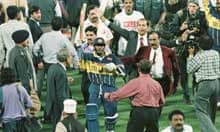
By the time 1996 came along, we had a full-blown civil war, a debt-ridden economy and a 14-year-old Test team that had been hammered around the world since being inducted in 1981. Two bomb attacks had cancelled two international tours. And two Marxist revolutions had cost more lives than the seating capacity of Colombo's Kettarama stadium.
In hindsight, it's easy to romanticise 1996. But truth be told, we were lucky. We qualified for the second round thanks to forfeits by Australia and the West Indies, scared off by our security situation. We lifted that cup in Lahore because we won three games on the trot. England in the quarters, India in the semis and Australia in the final.
But what a way to win. We had the world's most freakish bowler, a Tamil named Murali, whose action had been condemned by umpires in Australia. Perhaps 30 years ago we might have sidelined him, so as not to ruffle the feathers of our masters. Perhaps 30 years ago, we may have hesitated to send unorthodox stroke-makers such as Sanath and Kalu to open our batting. But by 1996 it was time to abandon the straight-bat approach we had once been taught. And a bunch of poorly paid amateurs, spurred by a decade of frustration, blasted their way to the cup.
While the victory did serve to unite the country, minorities were still under-represented in our national team. The call-up for international duty continued to elude many Muslim and Tamil cricketers who excelled at club level. Murali was merely the exception that proved the rule.
Despite the fairytale of '96, it wasn't the cricket that ended our civil war. It was the tanks and the fighter planes. Fourteen years on, our war is over and our cricketers have gone from international punching bags to national gods. We have a new political family in charge. And everyone expects us to win.
The '96 win meant that cricket became currency. Politics and big business flocked to it. Suddenly we had more stadiums, more tournaments, more foreign coaches. Suddenly we became something that we have struggled to be in most of our endeavours: professional.
But 1996's lasting legacy was something more precious than cash or column inches – 1996 gave us heroes. In our 48th year of independence, who else did we have to look up to? The soldiers pawned in the war? The overfed politicians? The martyrs of failed revolutions? For a nation short on heroes or causes for celebration, the sight of our boys in blue outwitting the world, at least for a moment, was one to behold.
Many of us believe in the myth of sport; some more than others. Clint Eastwood and Hollywood have turned the 1995 Rugby World Cup into a sport-conquers-apartheid fantasy in Invictus. CLR James believed cricket to be the catalyst for West Indian nationalism. A drunk in a Colombo cricket bar once told me that Rocky IV had hastened the fall of the Soviet Empire.
Let's abandon the myths for now. Sport cannot change a world. But it can excite it. It can galvanise a nation into believing in itself. It can also set a nation up for heartbreak.
Today, Sri Lanka HAS NO excuses for failing. We are one of six countries with a plausible chance of whacking the cup. We no longer have a war to hold us back. We no longer apologise for our idiosyncrasies. In fact, we embrace them.
Back on the street, the eight-year old edges the ball towards my feet. There is much shouting as runs are stolen and rules are disputed. I examine the ball before chucking it back to the shaggy-haired bowler. It was a tennis ball in a past life, but now the hairs of one side have been cauterised by flame. Industrial-strength duct tap marks a crude seam across its circumference. Presumably ball tampering is a legitimate art form on the streets of Colombo.
It explains how a hairy, overweight boy in a dirty singlet can reverse-swing a tennis ball like the Pakistan legend Wasim Akram. The skidding delivery is skied into the checkpoint and bounces off the sandbags. Three years ago, the checkpoint was the symbol of the garrison town that Colombo had become. Today it is an empty shell for stray cats to have kittens in.
The kid with the ball has modelled his haircut and his bowling action on Lasith Malinga, who joined a new generation of Sri Lankan heroes by taking four South African wickets in as many balls during the last World Cup. Malinga, a boy from the beach, slings the ball with a side-arm action like a discus thrower on steroids. It is as bizarre as Murali's wrist contortions, Ajantha Mendis's two-fingered carrom ball and Dilshan's bizarre scoop shot. It is as effective as it is strange.
People ask why Sri Lanka produces cricketing freaks. I have only theories. Our game is not born in grammar schools or coaching clinics, but on damp beaches, dusty roadsides and bush-ridden hills. To survive as a bowler in street cricket you need to bend the rules of bowling, while keeping your elbow straight. To survive as a batsman, you may have to abandon the coaching manual and trust your eyes.
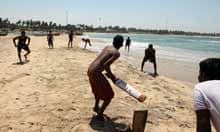
Malinga probably owes his technique to the wet sand he learned to bowl on, while Sanath, our most exiting batsman, may owe his lack thereof to the coconut trees that surrounded his childhood playgrounds. And Dilshan's so-called Dil-scoop is a familiar sight for anyone who has watched a Lankan street cricketer steal runs from behind the keeper.
But this is just more myth-making. Here are some facts. Outside of cricket, Sri Lanka is an underachieving nation with much ground to make up. We have squandered our resources and wasted our gifts. Whatever sporadic brilliance we have achieved is through bumbling, haphazard, last-minute gambles.
Has all that much changed since 1996? Yes and no. Cricket is still the only currency we possess that holds its value. The taxes that should be nurturing our flood-ravaged economy or investigating our human-rights abuses are being channelled into bigger stadiums and better players.
The government is now a family business. The Rajapakse dynasty's tentacles stretch across every Sri Lankan bureaucracy. The President's relatives dominate the cabinet and have been accused of persecuting journalists, stifling opposition and winning wars by carpet-bombing civilians. In order to live with itself, the nation needs to manufacture more heroes.
Two years ago, masked gunmen opened fire on the Sri Lankan cricketers' tour bus in Lahore. The bus was heading to the same ground where we won the World Cup a decade earlier. Having survived playing cricket amid war for the past 25 years, we almost lost our national team in someone else's squabbles. If those bullets had hit, the national tragedy may well have eclipsed the tsunami and reshaped South-East Asian regional politics.
As a cricket fan, I will be happy if the best team wins the World Cup, as long as that team isn't Australia. The dominance of the men in yellow over the past decade turned international cricket into a one-horse race. Their recent thrashing by England in the Ashes was applauded across the globe and rightly so.
I'll just be grateful for more thrillers like the India-England group match that ended in a tie and more blistering knocks from the likes of South Africa's Hashim Amla and the West Indian captain Chris Gayle. I'll be happy with close games and absorbing contests, regardless of who takes the cup.
But as a Sri Lankan, I demand more fairytales. I want to see cavalier batting, mystical bowling, impossible victories and beautiful cricket. I want to see the island's stadiums galvanised by drums. To hear the nation screech out of key, but in unison. I want to see belief defeat probability.
Today Colombo is lined with King Kong-sized billboards of the team's heroes Mahela, Sanga, Murali and Dilshan. Our crowds are the noisiest and the least forgiving. We demand victory because we think we deserve it.
Why? Because if nothing else, it'll convince us that postwar Sri Lanka can deliver on the greatness that the politicians have promised us. It'll help us believe that the unorthodox may inherit the earth. It'll show us that our tiny nation is capable of getting behind a single cause without bickering. And that the dark days of the 1980s need never be revisited.
Shehan Karunatilaka's Chinaman (Jonathan Cape, £12.99), is out on 28 April. He is one of "Waterstone's 11" for 2011


